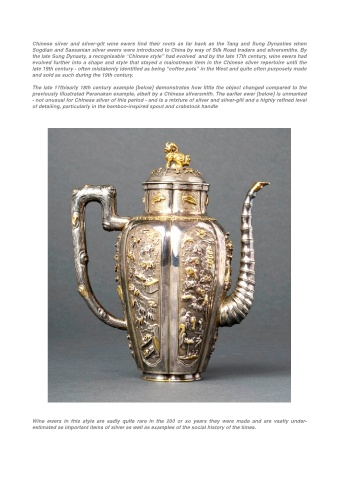Page 734 - Chinese SIlver By Adrien Von Ferscht
P. 734
Chinese silver and silver-gilt wine ewers find their roots as far back as the Tang and Sung Dynasties when
Sogdian and Sassanian silver ewers were introduced to China by way of Silk Road traders and silversmiths. By
the late Sung Dynasty, a recognisable “Chinese style” had evolved and by the late 17th century, wine ewers had
evolved further into a shape and style that stayed a mainstream item in the Chinese silver repertoire until the
late 19th century - often mistakenly identified as being “coffee pots” in the West and quite often purposely made
and sold as such during the 19th century.
The late 17th/early 18th century example [below] demonstrates how little the object changed compared to the
previously illustrated Peranakan example, albeit by a Chinese silversmith. The earlier ewer [below] is unmarked
- not unusual for Chinese silver of this period - and is a mixture of silver and silver-gilt and a highly refined level
of detailing, particularly in the bamboo-inspired spout and crabstock handle
Wine ewers in this style are sadly quite rare in the 200 or so years they were made and are vastly under-
estimated as important items of silver as well as examples of the social history of the times.

